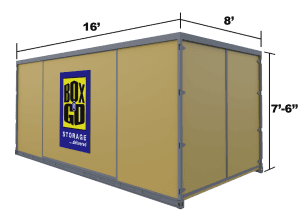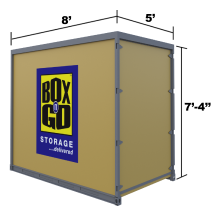Outside Self Storage Near Me: Pros & Cons

When you start searching for ‘outside self storage near me,’ you’re probably picturing those familiar rows of garage-like units. They seem straightforward enough—drive up, roll up the door, and unload. The convenience is undeniable. But what you don’t see from the road is what happens inside that metal box once the door is closed. Your belongings are left to face sweltering summer heat and freezing winter nights without any protection. Before you commit to the first drive-up unit you find, it’s worth asking if that convenience comes at too high a cost, especially when it comes to protecting your most valuable possessions.
- Save 50% on move-in
- No truck rental
- Ground level










- Save 50% on move-in
- No truck rental
- Ground level
Box-n-Go Portable Storage Unit Sizes

Key Takeaways
- Understand the Trade-Offs of Outdoor Storage: These units offer easy, drive-up access at a lower price, but that convenience comes at the cost of exposure to extreme weather and fewer security layers.
- Protect Your Items from the Elements: Since outdoor units aren’t climate-controlled, you must proactively safeguard your belongings. Opt for waterproof bins over cardboard boxes and use moisture absorbers to prevent damage from humidity.
- Simplify Your Move with a Portable Container: Skip the rental truck and the hassle of loading twice. A portable container is delivered to you, allowing you to pack at ground level and on your own schedule, saving significant time and effort.

What Is an Outside Storage Unit?
Think of an outside storage unit as your own personal garage, just located at a storage facility. These are the units you typically see in long, single-story rows when you drive by. The defining feature is direct, drive-up access, which means you can park your car, truck, or moving van right in front of the roll-up door. This makes loading and unloading heavy or bulky items much simpler. They come in various sizes, but they all share that convenient, ground-level design.
Common Types of Outdoor Storage
The most familiar type of outdoor storage is the classic drive-up unit. Because you can access them so easily, these spaces are a popular choice for people who need to get to their items frequently. Think of business owners storing inventory they need to grab on the way to a job, contractors with tools and equipment, or families swapping out seasonal decorations. Some facilities also offer outdoor parking spaces for vehicles like RVs, boats, or extra cars, which is a different category of storage altogether. But for most people looking to store household goods or business items, the traditional drive-up storage unit is the go-to option.

Drive-Up vs. Indoor Units: What’s the Difference?
The biggest difference comes down to convenience versus protection. With an outdoor unit, you can pull your vehicle right up to the door, which saves you a ton of time and physical effort—no long walks or navigating tight corners. Indoor units, on the other hand, are located inside a larger building. To access them, you’ll likely have to park, load your items onto a cart, wheel them through hallways, and possibly use an elevator. While indoor units offer better protection from the weather and pests, they are often smaller and might not work for storing very large items like vehicles, large appliances, or bulky furniture.
How Secure and Accessible Are They?
That easy, drive-up access is a double-edged sword. It’s incredibly convenient for you, but it can also create security vulnerabilities. Because the units are outside and so accessible, they can be more exposed to potential theft or damage, even when the facility has security cameras and gated access. An indoor facility offers extra layers of protection—like a main building entrance that requires a code and interior hallways—that an outdoor unit simply doesn’t have. You’re essentially trading a higher level of security for the convenience of parking right at your unit’s door. It’s a key trade-off to consider based on what you plan to store.
Store on your driveway or inside our secure facility. Load/unload only once. Ground level access.
Protecting Your Belongings from the Elements
This is a big one. Standard outdoor units are essentially metal boxes that are not insulated or climate-controlled. They don’t regulate temperature or humidity, which means your belongings are exposed to the full force of the weather. During a hot summer, the inside of that unit can get incredibly hot, and in the winter, items can freeze. This extreme fluctuation can easily harm sensitive items like wooden furniture (which can warp or crack), electronics, important documents, photos, or artwork. If what you’re storing is valuable, sentimental, or irreplaceable, the lack of climate control is a major risk to consider.

The Pros and Cons of Outside Storage
When you picture a storage facility, you’re probably thinking of those long rows of garage-like doors. These are outdoor, or drive-up, storage units. They’re a popular choice for a reason, but they come with their own set of trade-offs. Let’s break down what you need to know before you commit.
The Upsides: Why People Choose Them
The biggest draw for outside storage is convenience, plain and simple. You can pull your car or truck right up to the door, which makes loading and unloading heavy or bulky items a breeze. There are no long hallways, tricky corners, or elevators to deal with. This direct vehicle access is a major time-saver, especially if you plan on visiting your unit often. Because these units are more basic and don’t typically include climate control, they are often the most affordable option. You can also find them in larger sizes, giving you more square footage for your money. For many, the combination of easy access and lower cost is hard to beat.
The Downsides: What to Watch Out For
The same features that make outdoor units affordable also create their biggest risks. Since they’re essentially metal garages, they aren’t sealed off from the elements. This means your belongings will be exposed to the same temperature and humidity swings as the weather outside. This lack of climate control can be disastrous for items like wooden furniture, electronics, artwork, and important documents. Security can also be a concern. While most facilities have fences and cameras, outdoor units can be more exposed than their indoor counterparts. They are also more susceptible to pests like insects and rodents finding their way inside. Finally, you’ll want to double-check your insurance policy, as you may need extra coverage for items stored in a non-climate-controlled space.

How to Choose the Right Outdoor Unit
Picking the right outdoor storage unit isn’t just about finding the closest or cheapest option. It’s about making sure your belongings will be safe, secure, and in the same condition as when you left them. Before you sign any rental agreement, take a moment to walk through a few key considerations. Thinking about your specific needs now will save you a lot of headaches later.
Figure Out What You Really Need
First, get clear on what you’re looking for. Start by estimating how much space you’ll need. It’s easy to underestimate, so it helps to use an online size guide to visualize how your items will fit. Consider the length of your storage term—are you storing for a month during a move, or for a year while you’re out of the country? Also, think about what you’re storing. If you have items sensitive to temperature swings, like wooden furniture, electronics, or important documents, an outdoor unit without climate control might not be the best fit. Finally, weigh convenience against your budget. A facility right down the street is handy, but one a few miles further out might offer a better price.
- Call or order online in minutes
- We deliver storage to you
- Pack at home, at your convinience
- Store on your property or at indoor facility
- Move locally or nationwide
- Call or order online in minutes
- We deliver 16′ and 20′ storage to you
- Pack at home, loading labor available
- Store on your property
- Secured Extra Space
Key Features to Look For
Once you have a list of potential facilities, it’s time to check them out in person. Pay close attention to security. Look for essentials like gated access, good lighting, and visible security cameras. A secure facility gives you peace of mind that your things are protected. The overall condition of the property matters, too. Are the grounds clean and the driveways paved and well-maintained? Check the unit doors—they should be solid and seal properly to keep out pests and moisture. Don’t forget to ask about their tenant insurance policies. Your homeowner’s or renter’s insurance might offer some coverage, but it’s always best to know all your options.

Keep Your Items Safe and Dry
Even the best outdoor unit is still exposed to the elements, so you need to pack smart. Using sturdy, waterproof bins instead of cardboard boxes is one of the best ways to protect your belongings from potential moisture. Make sure you pack everything correctly, leaving no empty space in boxes and using packing materials to cushion fragile items. To combat humidity, toss a few moisture absorbers, like silica gel packs, inside your unit. And finally, try to check on your unit every so often. A quick periodic visit lets you make sure everything is still safe, dry, and in good order, catching any potential issues before they become big problems.
Is There a Better Way? Exploring Modern Alternatives
If the thought of renting a truck, hauling everything across town, and navigating narrow hallways just to unload your belongings sounds exhausting, you’re not alone. Traditional self-storage has its place, but it often involves a lot of heavy lifting and logistical gymnastics. What if you could skip half of those steps?
Modern storage solutions are designed to eliminate the biggest hassles of moving and storing. Instead of you going to the storage unit, the storage unit comes to you. This approach, known as portable storage, streamlines the entire process. It’s built for people who value their time and would rather not spend a weekend loading and unloading their stuff multiple times. By bringing the storage directly to your doorstep, this alternative cuts out the middleman—the rental truck—and simplifies your move from start to finish. It’s a more efficient, flexible way to handle your storage needs, whether you’re decluttering, renovating, or in the middle of a move. It puts you in control of the timeline and the labor, making a typically stressful event feel much more manageable.
We deliver the best storage solutions. No gimmicks:
- No truck to rent. We deliver storage to you!
- Load/Unload only once.
- Pay only for space you use.
- Secure, climate-friendly facility.
- Drive-up access
No Truck to rent…EVER!
- Save money and time.
- Reduce the risk of accidents and injuries.
- No need to pay for gas, insurance & mileage!
Load ONCE Storage Solution!
- You only need to load your belongings once!
- No need to load and unload it all again into a storage unit.
- All containers come with easy ground level access!
Pay Only for the Space You Use!
(if storing at our facility)
- No not need to guess on how much space you actually need.
- Order an extra 8’ x 5’ unit. Do not use it – do not pay for it.
Secure, Climate-Friendly Facility!
- Highest degree of security and protection.
- Our 8’ x 5’ units are breatheable – no mold or mildew.
- No funky smell when your belongings return.
EASY Drive-Up Access!
(if storing at our facility)
- Access your units at ground level.
- No elevators, ramps, stairs to climb.
- Schedule access appointment & drive straight to your units.
The Perks of Portable Storage
The biggest advantage of portable storage is pure convenience. A container is delivered right to your door, allowing you to pack at your own pace, right where you are. This completely changes the game because you only have to load and unload your belongings once. You pack the container, and that’s it. There’s no need to load a truck, drive it to a facility, and then unload everything again into a storage unit. You also get more flexibility. You can keep the container on your property for easy access or have it picked up and stored in a secure, indoor facility. This gives you an added layer of security and protects your items from the elements. Plus, with flexible rental terms, you can keep the unit for exactly as long as you need it, without being locked into a long-term contract.

Understanding the Costs
When you’re looking at storage, you want clear, predictable pricing. Portable storage costs are typically broken down into a few simple parts. You’ll have a monthly rental fee for the container itself, which is the main recurring cost. Instead of paying for a rental truck separately, you’ll have straightforward delivery and pickup charges for when the container is brought to you and when it’s taken away. Beyond the basics, you can also get insurance to make sure your belongings are protected. Many companies also offer other services to help with your move, like providing packing supplies or connecting you with professional movers. This transparent structure makes it much easier to budget for your storage needs without worrying about hidden fees or surprise charges down the road.

20’ Container – all weather.
Perfect for 3-bedroom residence.
5-7 rooms, furniture, appliances, etc.

16’ Container – all weather.
Perfect for 2-bedroom residence.
3-5 rooms, furniture, appliances, etc.

8’ Container – all weather.
Modular – works for any need.
Each fits 1-1.5 rooms.
Features That Make Your Life Easier
Portable storage is designed to reduce the physical strain of moving. One of the best features is that the containers are at ground level, so you can walk right in. This means no ramps are needed, which saves your back and makes loading heavy or bulky items like furniture much simpler and safer. If you need an extra hand, some services can even help with the loading process. You also have the choice to keep the container at your home for on-site storage or have it moved to a secure facility. This flexibility is perfect for different situations, whether you’re renovating and need tools nearby or moving and want your items stored safely out of the way. With terms that fit your schedule, you’re in control of the timeline, making the entire process feel less stressful and more manageable.
Related Articles
- Traditional vs Portable Storage: Pros, Costs & Convenience
- Indoor Self Storage: Your Complete Guide – Box n Go Storage and Moving
- Temperature-Controlled Storage: Benefits & Costs | Box-n-Go
- Secure Self Storage: Essential Features for Peace of Mind – Box n Go Storage and Moving
- Self Storage Near Me: Compare & Choose Wisely
Frequently Asked Questions
What kinds of things should I avoid putting in an outdoor storage unit? Because outdoor units aren’t climate-controlled, you should be careful about storing anything that can be damaged by extreme heat, cold, or humidity. This includes items like wooden furniture that can warp, electronics, important papers, photographs, and artwork. If an item is valuable or sentimental, the lack of temperature regulation in a standard outdoor unit poses a significant risk.
Is an outdoor unit really less secure than other options? It’s less about being insecure and more about having fewer layers of protection. With an outdoor unit, the main security features are your personal lock and the facility’s perimeter fence and cameras. An indoor unit, or a portable container stored in a secure warehouse, adds extra barriers. You often need a code to enter the main building, and your unit is then located inside, away from direct street access.

How is portable storage different from just renting a drive-up unit? The main difference is how you get your belongings into storage. With a drive-up unit, you do all the work of renting a truck, loading it at your home, driving to the facility, and unloading it into the unit. Portable storage reverses that process. A container is brought to your home, you load it once, and then it’s picked up and taken to a secure facility for you. It cuts the loading and unloading work in half.
Are outdoor units always the cheapest option? While the monthly rental fee for an outdoor unit might be lower, it’s important to consider the total cost. You’ll likely need to budget for a truck rental, gas, and moving equipment, which can add up quickly. When you compare the all-in cost and the amount of work involved, a more streamlined solution like portable storage can often provide better overall value.
If I’m moving and need temporary storage, do I have to rent a truck? If you choose a traditional outdoor storage unit, then yes, you are responsible for transporting all your belongings to the facility. This almost always involves renting a moving truck. The main appeal of modern alternatives like portable storage is that they eliminate this step entirely by delivering a storage container directly to your door.

